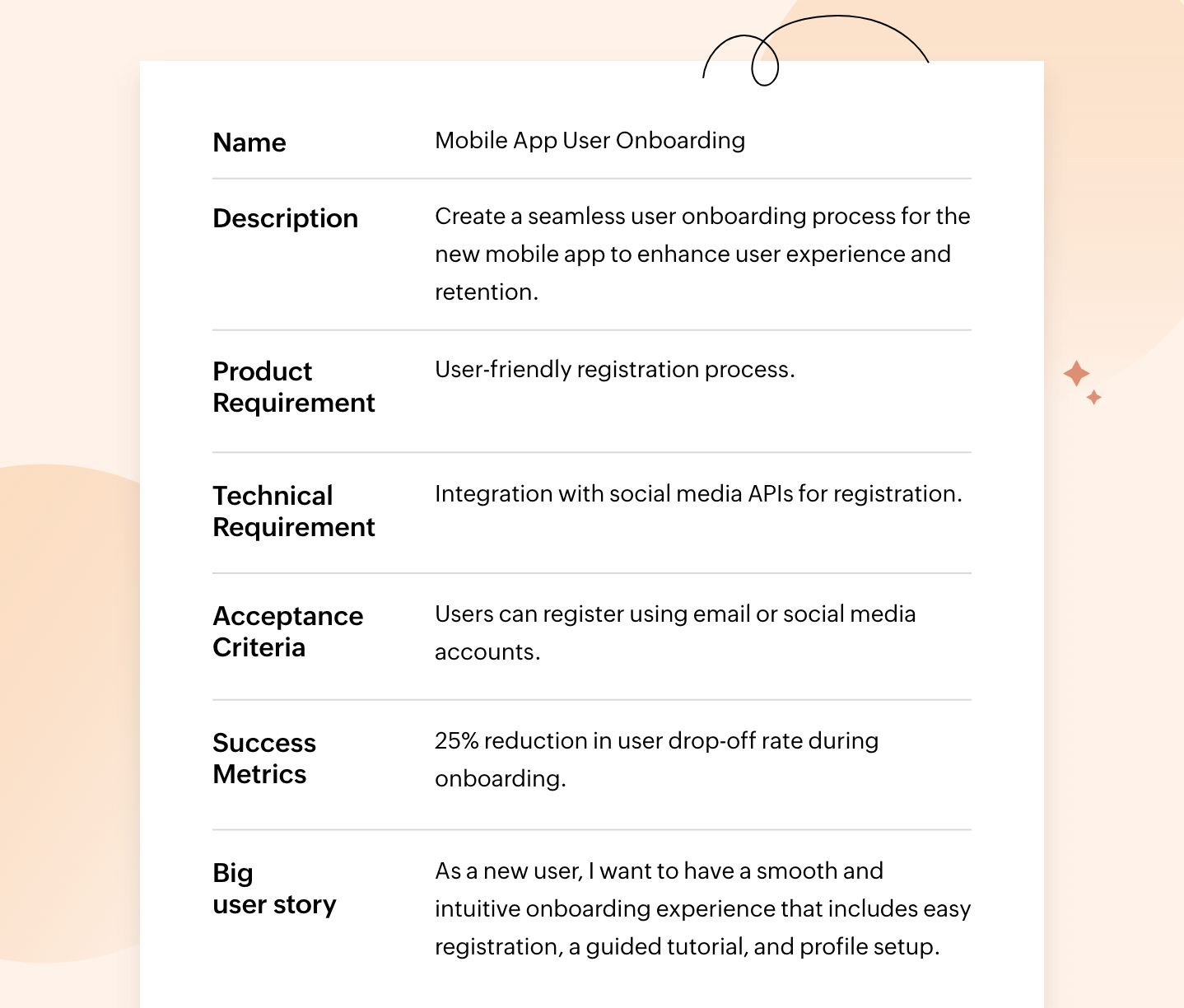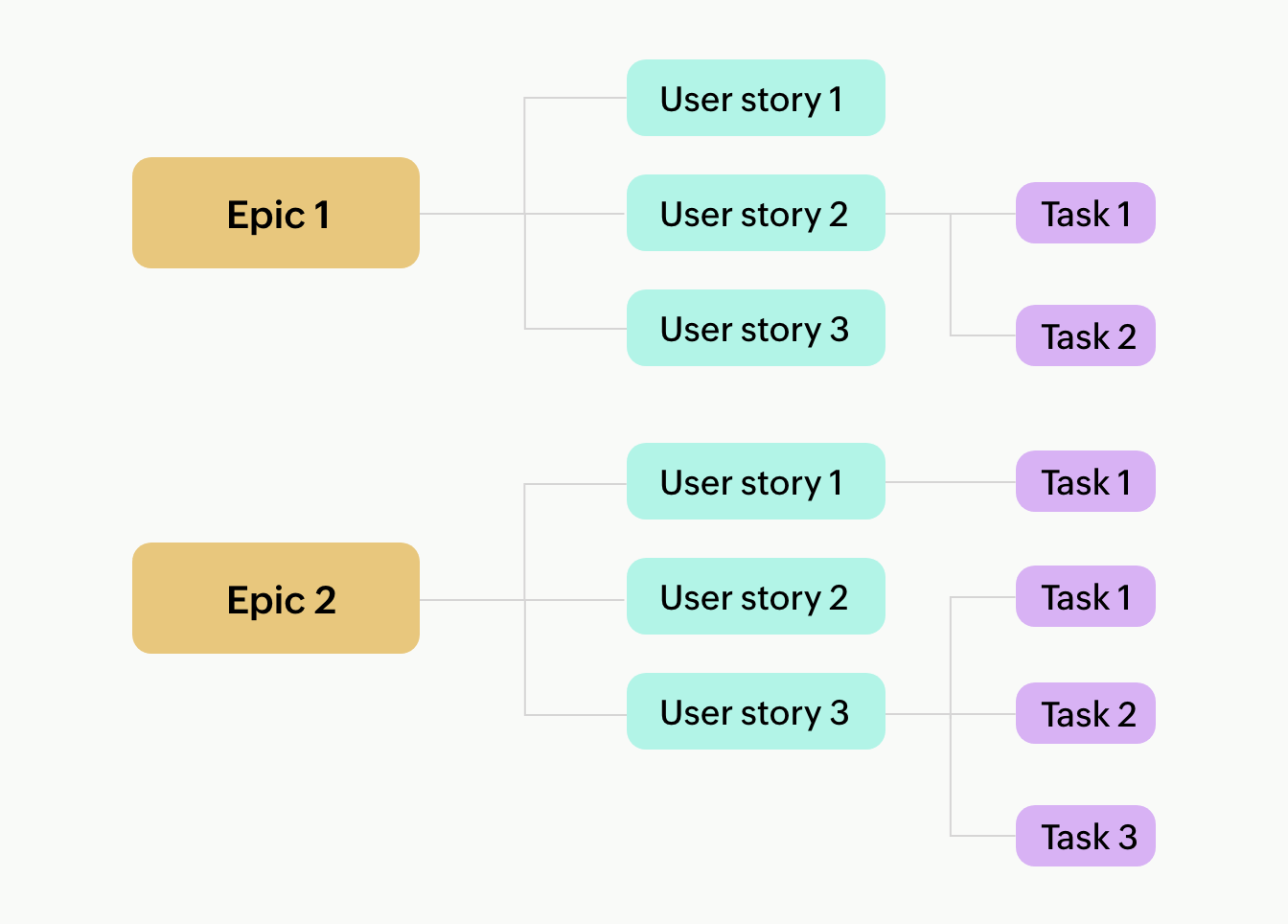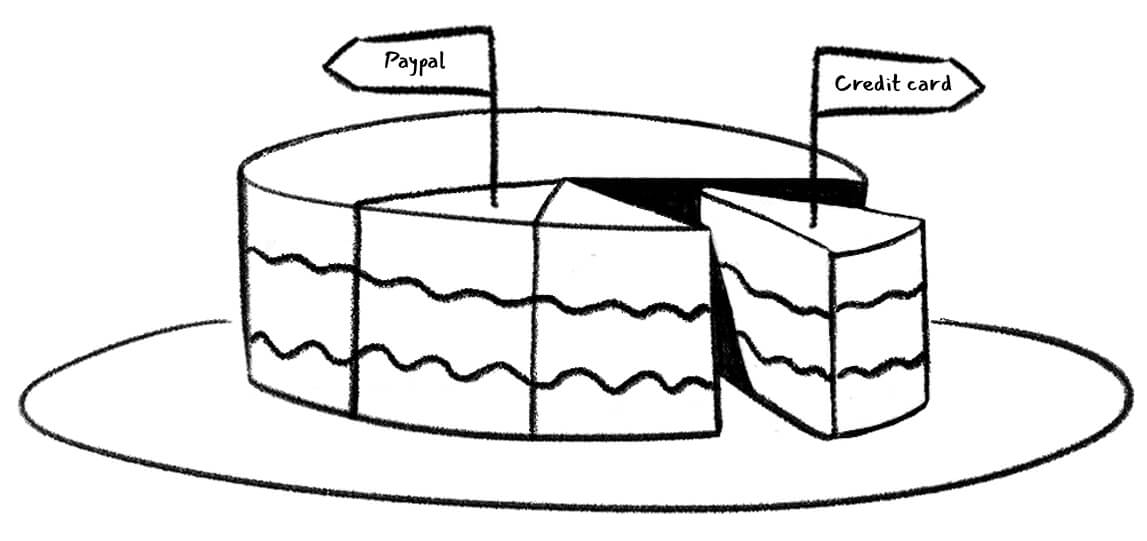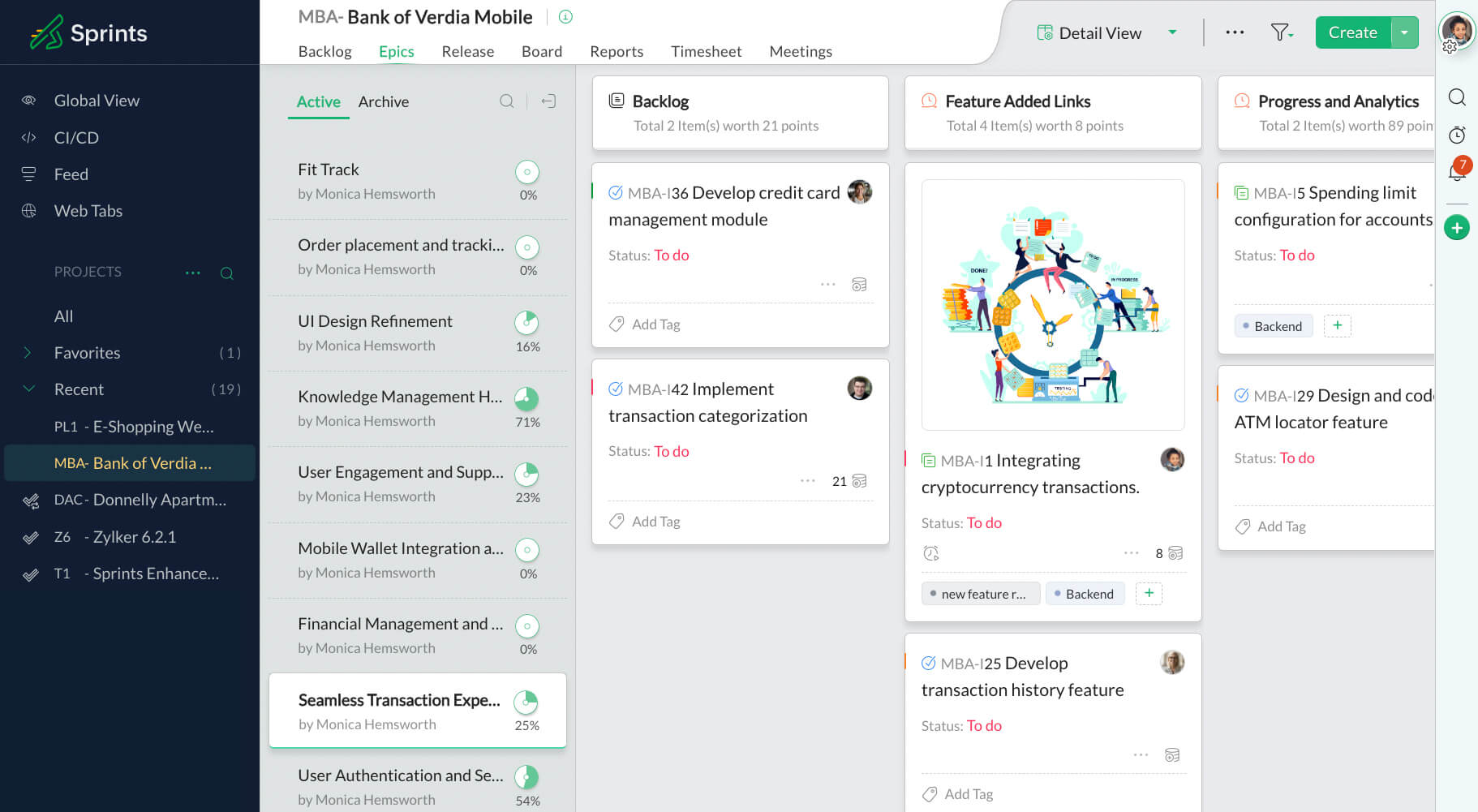What is an epic?
In agile methodology, an epic represents a large body of work that cannot be completed within a short period of time. Agile epics are typically broken down into smaller, more specific segments known as user stories, often spanning multiple teams and sprints. An epic can encompass a new feature, a feature enhancement, an entire product, or a complex customer requirement.
Let's consider a scenario where a birthday celebration event with 100 guests needs to be planned and executed. The event planner assigns specific tasks to respective teams; the planning team handles venue booking, the creative team manages venue decoration, and so on. These actionable items are known as user stories in agile methodology. A user story within an epic can be further broken down into smaller action items called tasks.
An epic is created based on the needs of customers and end-users. Epics are designed to be flexible, enabling seamless adjustments and adaptations to align with customer feedback and suggestions. If the client requires a change to the agreed-upon menu for the birthday event, the event planner will promptly inform the hospitality team in charge of the food to make the necessary changes before the event.
Unlike sprints, epics in agile do not have a set timeframe for completion. Ideally, the process of completing and delivering an epic will take between one to three months, depending upon the complexity and rounds of improvements.
Just like how completing many smaller tasks contributes to an overall successful event, leaving guests satisfied, the triumph of an epic is determined by completing all the user stories within it, ultimately delivering value to the customers. In other words, epics act as a bridge to transform initiatives into quantifiable values.
Why do you need epics?
Epics are used in agile software development to classify your user stories and lend a structure to your backlog. For example, if you're working on two-week sprints and you take on an integration between your product and a third-party application, it will likely take more than a single sprint to complete. This is where you can use epics. Your epic could be called <Product Name> Integration and the user stories required to achieve it could be spread across multiple sprints.
It's often not clear what our path is when we set off, so epics are a useful way to capture ideas and flesh them out as we go. In this way, an epic can be useful as a placeholder.
An epic can also help you capture abstract ideas with a single item in your backlog until your team decides to break it down into user stories. You could have an epic titled "Online Payment" in your backlog and you could flesh it out (Credit card, debit card, store credits..) when your team takes it up during their sprint planning meeting. Epics help identify milestones in your feature roadmap, or even features themselves, making your work more organized and easier to track.
4 benefits of agile epics
Agile epics benefit your project management by breaking large objectives into small and tangible work items, which improves team collaboration, and enhances stakeholder engagement. Here are a few key benefits of using epics:
Strategic decision-making
One of the biggest challenges every team encounters is the planning and prioritizing of projects with large objectives. Agile epics simplify complex projects by breaking down large objectives into manageable segments, and helping teams and stakeholders prioritize work efficiently and make strategic decisions without overlooking requirements.
Defines the scope of the project
Epics outline a clear and detailed scope of the feature or functionality from the end-user's perspective. This helps the team break the epic down into the required number of user stories and tasks needed to accomplish an epic feature.
Increased transparency and communication
Epics provide a clear understanding of the overall objective of the project, helping teams collaborate and contribute efficiently with a shared understanding of the project's goals and priorities.
Greater flexibility
As new priorities and requirements surface due to an evolving customer base and market dynamics, you can readjust and reprioritize agile epics (as epics are made up of multiple user stories and tasks) to accommodate the changing requirements without hampering the progress of your project.
How big should an epic be?
Based on the practices of a team, they decide how high-level or granular an epic should be. It also depends on their need for an extensive hierarchy in their work: some teams mandate that all their user stories need to be classified under one epic or another while other teams work with a more relaxed approach. Some teams complete their epics in a month and some run theirs over the course of several months.

Breaking down an epic
Whether you're breaking down an epic, a user story, or any work item in your backlog into tasks, it's important to remember to split them across functional boundaries and not technical ones. For example, if the work item is enabling online payment for an ecommerce store, you can split it into "Debit card payment" and "Credit card payment" instead of "Design," "Development," and 'Testing."
Horizontal breakdowns often cause bottlenecks since every item will be dependent on other items and not be able to contribute any value by itself. It also creates technical silos within the team and works against a shared understanding of what the team is working on.
Best practices for using agile epics
Epics first, then user stories
Epics provide a hierarchical structure for your large project objectives and goals. It's always ideal to write epics first and then break them down into small, detailed user stories to achieve them strategically. This approach helps you track and prioritize project goals systematically and comprehend completed and outstanding milestones.
Write your epics well
When creating an agile epic, be mindful of the end user of this information. It's crucial to name an epic effectively and outline the expected outcome in a detailed and easy-to-understand manner. This practice helps in creating specific user stories and enables the agile team to understand what they're expected to develop.
Coordinate with multiple teams
Epics are an ideal for managing multiple work items and coordinating with different agile teams to achieve the goal. They can accommodate tasks across various teams, increasing transparency and efficiency. This structure makes it easier to monitor progress, coordinate efforts, identify bottlenecks, and make informed decisions.
Measure the success of your epics
Establishing clear success metrics is a critical step when creating agile epics. These metrics outline the expected outcome, ensuring teams remain aligned and focused on achieving the objectives.
Incorporating objectives and key results (OKRs) into your epics is an excellent way to define objectives, set targets and monitor progress. This approach allows you to gauge whether the epics are moving closer to their targets or facing delays.
How to write an epic
Creating an agile epic is a team effort; no single person writes one. Epics provide a hierarchy to your work and should ideally be written before user stories, allowing for more specifics and detailed stories based on a high-level overview of your objective. Here are steps to write a successful epic:
1. Name or label the epic
The first step to writing a good epic is giving it a name that briefly describes what the epic aims to achieve. For example, the epic name could be "Enable in-app payments and paywall access." This title is concise and clear, promoting transparency and reducing the chances of miscommunication.
2. Define the epic
Describe the epic, outlining the expected outcome. The description should be simple yet detailed enough for your team to understand easily. Ensure that your narrative addresses these three key points:
Who? Who is the final product for? The description should address whether it is a feature enhancement, a new feature to improve the experience for existing customers, or a new product/feature to attract new customers.
What? An epic should answer questions like: What is the objective of this epic? What does the team plan to achieve with this epic?
Why? An epic description should include a detailed explanation of why the team needs to develop this feature/product and what value it will add to the business.
3. Establish the scope
Once you've provided a detailed description of your epic, the next step is to list the work to be done and set boundaries for the epic. Establishing the scope of the epic is vital to ensuring team members understand what they need to do. This reduces the chances of the epic going off track.
For the agile epic "Enable in-app payment and paywall access," you would want to specify the banking regulations and data privacy standards the transactions and data handling must adhere to. Additionally, you should list the banks the app will support to integrate with those banks' backend systems, process payments securely, and link them to user accounts.
4. Define acceptance criteria
It's crucial for your team to understand when an epic is deemed complete. Agile epic acceptance criteria outline a list of requirements that describe how the team should build the product or feature. They also act as a checklist for your team to ensure it's met all feature requirements before marking an epic as done.
5. Break the epic into user stories
Once you've finished writing an epic, the next step is to break it down into small, detailed user stories and actionable tasks, and add them to your product backlog.
Agile epics template
There is no specific format for writing agile epics. The style of writing an epic may vary depending on the team's functioning. However, there are a few important factors necessary to create a good epic within the agile methodology:
- Select an appropriate name for your epic that is self-explanatory.
- Outline the expected outcome, detailing what you plan to achieve and why. An epic description can include an introduction,technical requirements, product requirements, and expected outcomes (acceptance criteria).
- Include success metrics related to your epic to determine what you expect upon its completion.
- List user stories within the epic for a clear understanding of how it is broken down to achieve the larger objective.

Agile epic examples
An epic is more than just an umbrella of user stories; it serves as a cornerstone for effective planning and execution to meet the bigger goals. Epics in agile provide a strategic perspective to projects, allowing teams to prioritize and sequence work based on the value it brings to the end-users and stakeholders.
Let's explore a few examples of epics in various contexts to understand how epics help structure and organize work, facilitate collaboration, and ensure that the development process remains aligned with the project's overarching goals.
1. Constructing a house
Let's consider the construction of a single-story house as a project, in which one of the epics will be the building of a garden inside the house. The contractor is in charge of the epic and will break it down into smaller actionable items called user stories. The user stories can include:
- Constructing the floors of the garden
- Building walls around the garden
- Selecting decor and plants for the garden
Each user story will include numerous tasks. These tasks will have a fixed timeframe within which the task needs to be completed (e.g., selecting the correct tiles, fixing the tiles, painting the walls, or electrical works in the garden).
2. New feature on a landing page
Another example of an epic is the addition of gamification features to a landing page. The project manager will break the epic into smaller user stories and assign a team to build the feature. The user stories can include:
- Implement a Scratch and Win feature to let a page visitor win exciting gifts and coupons.
- Create at least three variations of UI for this feature.
- Create and share the front-end HTMLs of the feature.
These user stories can then be broken down into smaller tasks and added to sprints. Once all the user stories are completed, the feature can be tested to ensure the functionality is working smoothly and then prepared for delivery to the end users.
Epic burndown chart
In the realm of agile, where multiple sprints run simultaneously and several iterations unfold within an epic, we often find ourselves asking, "How are we progressing towards the end goal? Is the epic moving at the right pace? Are we on track to meet the deadlines?"
It is like being in a confusing maze if you don't know where your epic is heading or whether it is on the right track. This eventually leads to delayed deliverables and unhappy end-users. An epic burndown chart is an excellent visual representation that can help you visualize your epic’s progress, manage and prioritize the workload efficiently, and ensure those planned deadlines are met.
The epic burndown chart depicts the amount of work remaining in an epic—consisting of unfinished or newly added user stories, tasks, and bugs—versus the time it will take to complete the epic. This chart helps project managers analyze and predict whether an epic can be completed by the planned deadline. Not only does this enable you to prioritize work items and estimate the total number of sprints required to complete the epic, but it also helps you understand your team's productivity level. If your team is overburdened, the work items within the epic can be prioritized such that the team works only on essential tasks to complete the epic. Likewise, if your team is underutilized, the work items within the epic can be prioritized in a way that allows your team to take on additional non-essential tasks to enhance the epic further.
How to read an epic burndown chart
An epic burndown chart consists of different components that the project manager and the team must clearly understand.
X-axis: This is the horizontal axis that represents the time allotted to complete actionable items within an epic.
Y-axis: This is the vertical axis representing the remaining efforts required to complete the work items within an epic.
Against each axis, two important lines help the reader interpret the chart:
1. Ideal work remaining line: This line represents the perfect workload distribution amongst the team members, estimated with no setbacks or add-ons in the epic's progression. This is a downward sloping line starting from the very top of the y-axis and ending at the far right of the x-axis.
2. Actual work remaining line: The actual work line represents the real work remaining to complete the epic. This line will differ from the ideal work remaining line due to unexpected requirements, slow tasks, and bugs.
Project managers use these lines to track expectations against reality. If the actual work remaining line sits above the ideal work remaining line, it reads that the team is running behind in meeting the epic deadline. This information helps project managers make the right decisions to modify estimations and expectations.
While the burndown chart helps project managers and teams align with the epic's goals and timelines, it also provides a high-level view of the epic's status to the stakeholders so they can make critical business decisions.
Enhance your epics through automation
In agile epic management, automation has become integral to increasing productivity and improving efficiency for a streamlined and successful implementation of epics with fewer human errors. Leveraging automation in epics can help teams reap numerous benefits, allowing them to focus on delivering value. Here are some key benefits of introducing automation into epic management:
- I.) Automated progress tracking: Updates each epic's status based on the completion of associated user stories and bugs.
- II.) Automated real-time reports: Provides insights into epic performance and identifies blockers, facilitating informed decision-making.
- III.) Automated notifications and updates: Enhances coordination and clear communication with stakeholders and team members in real time.
- IV.) Automated timesheets: Provides accurate data on work hours spent on each epic by the team.
- V.) Automated dependency mapping: Identifies and quickly resolves blockers.
Using epics in Zoho Sprints
We understand the purpose and usage of epics in your scrum process and we've taken care to reflect this in our product design. Instead of cluttering your backlog with all your epics and user stories, we created a separate view for epics where you can see all your epics along with their user stories spread across multiple sprints.
Zoho Sprints also includes epic reports so your team can track your epic progress and get a bird's eye view of how your product is coming along.
Epics are a tool to classify and structure your work. Using hierarchy in your work is a delicate line to toe: the right amount can lend clarity, while an excess of it becomes counterintuitive. Zoho Sprints supports a relaxed work structure, which can work for all teams. Whether your team works on long-term projects with a strict hierarchy, or on short ones with smaller software cycles, we've got you covered.
FAQ
How do epics differ from stories in agile?
An agile epic is a high-level body of work with large objectives, broken down into smaller, achievable chunks called user stories. Epics span multiple functionalities and modules of the product and cannot be completed in a single iteration or sprint
User stories are detailed requirements from an end-user's perspective, stemming from an epic. Completing multiple user stories achieves an epic. Unlike epics, user stories are smaller and can be finished within a single iteration or sprint.
What are the different types of epics in agile?
Agile epics can be categorized into different types based on context, scope, and requirements.
Business epics: These epics align with the overall business strategy and objectives to deliver business value, which in turn increase revenue, boost customer satisfaction, and enhance competitive edge. Example: Launching a new product or feature.
Portfolio epics: These epics are large in scale and span multiple teams across the organization, and possibly multiple products. They are strategic and align with the organization's long-term vision and goals. Example: A strategic partnership or a large business initiative.
Customer epics: These epics are closely tied to customers. They focus on tapping into new opportunities and trends to enhance customer experience with the product or service through customer feedback and market research.
Technical epics: These epics focus on the technical work in the background to support the development of business features and overall product improvement. They often include work items like performance optimizations, maintenance work, and technical upgrades for a seamless development process.
What are sprints and epics in agile?
A sprint is a time-boxed period to complete a set of work items, planned and tagged to a sprint. A sprint can include work items from multiple epics in a project. The completion of multiple sprints directly affects the progress rate of agile epics.
The agile definition of an epic is a large work item that is broken down into multiple smaller and achievable work items called user stories. An epic looks at customer needs at a higher level, and it may include various user stories, sprints, and teams with specific values.



